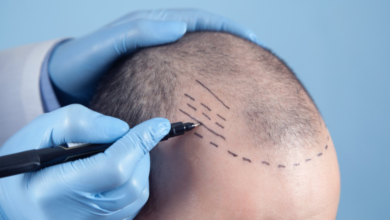Rosacea: Symptoms and Management Strategies

Rosacea is a long lasting skin condition that can make your face turn red and look like it has visible blood vessels. It can occur at any age, but is most common in fair skinned people who develop it in adulthood. If you suffer from this condition it’s important to understand the symptoms and what works to help manage them.
Symptoms of Rosacea
Symptoms associated with rosacea vary in intensity. The most common signs include:
- Facial Redness: It may begin as a tendency to flush easily and then advance to the face permanently red in the central part.
- Visible Blood Vessels: The nose and cheeks may develop small, dilated blood vessels that are easily noticeable, contributing to appearance of a flush.
- Bumps and Pimples: Bumps and pimples break out in many people with rosacea. They may be mistaken for usual acne, and usually are without the blackheads characteristic of acne.
- Skin Sensitivity: The skin is more susceptible to burning and stinging with some products in people with rosacea.
- Dryness or Flaking: It may be dry or irritated, and you may have areas of rough surface skin.
- Eye Problems: Rosacea can sometimes affect the eyes, causing redness, irritation or feeling gritty.
Management Strategies
There is no cure for rosacea, but management strategies can decrease flare ups and make the skin look better. Here are some effective approaches:
- Identify Triggers: Keeping a journal of flare ups can help you determine what kinds of triggers you are sensitive to, such as certain foods, drinks, weather, or beauty care products. Spicy foods, alcohol and extreme temperatures tend to be common culprits.
- Gentle Skincare: Choose mild, fragrance free cleansers and moisturizers. Harsh scrubs or exfoliants will irritate sensitive skin so avoid them. If they’re not soothing ingredients, look for products that include aloe vera or chamomile.
- Sun Protection: For many with rosacea, sun exposure is a big trigger. It is important to use broad spectrum sunscreen of SPF 30 or higher. You may also protect your skin by wearing wide brimmed hats and seeking shade.
- Medications: Metronidazole or azelaic acid are topical treatments that will reduce redness and breakouts. More serious cases may be prescribed oral antibiotics such as doxycycline. In any case, it is always advisable to speak to a dermatologist about what your best medication would be.
- Laser Therapy: Laser treatments can be effective, however, for those that suffer from persistent redness or visible blood vessels. These procedures use tactics that address and narrow out enlarged blood vessels, bringing out an even skin tone.
- Lifestyle Modifications: A healthy lifestyle will go a long way. Yoga, meditation and regular exercise can help you manage stress, the number one trigger that can lead to flare ups. Also, eating a diet high in antioxidants from fruits, vegetables, and quality whole grains can help overall skin health.
- Regular Dermatologist Visits: Regular check ups with a dermatologist monitor the condition and change treatment plans as required. They can also help you get an effective skincare routine personalized for the skin type of yours.
- Emotional Support: Rosacea can affect self esteem and cause social anxiety. Telling someone about your trials and tribulations or joining support groups or talking to a therapist can supply very important emotional help and dealing approaches.
Conclusion
Fortunately, rosacea, though often difficult to manage, is a condition whose symptoms and responses to treatment can be greatly improved with understanding, effort, and selfcare. With the right education on triggers, using gentle products, as well as consulting with a dermatologist, taking steps to find your nourishment within helps to manage this condition more easily. Fortunately, with the appropriate strategy, rosacea can be kept under control and your skin will be healthy and vibrant. You can visit oladoc to speak to a dermatologist online or in person visit



